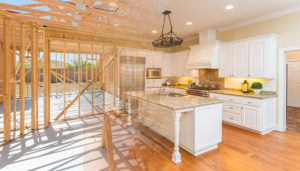Home Improvement Guide
 Millions of people renovate their homes every year. However, home remodeling projects are no easy task since they are generally a pain starting from finding the right contractor to handling the occasional hiccups. And then there is the case of the budget.
Millions of people renovate their homes every year. However, home remodeling projects are no easy task since they are generally a pain starting from finding the right contractor to handling the occasional hiccups. And then there is the case of the budget.
However, according to the joint report published by the National Association of Realtors and the National Association of the Remodeling Industry, the headaches and the sleepless nights are well worth it. 74% of the homeowners prefer staying in their homes after a remodeling project.
Be it adopting the latest trends, adding more space, upgrading the kitchen, or increasing energy efficiency, a home remodel constantly increases the resale value of your home. Despite that, this is a vast ocean to navigate, if you do not have any help.
This article brings to you everything you need to know about home improvement, planning, home remodel projects on a budget, tips, and much more.
Home Improvement Planning
Before jumping to the more exciting parts of a home remodel like paint colors, fixtures, and fittings, you need to step back, plan the renovation, what goes into it, mistakes to avoid, etc.
With a clear understanding of the home remodeling process, you can take it one step at a time, reduce stress, and make the entire process smooth and straightforward.
Here are the important steps involved in a home renovation project:
Have a Clear Vision
The first step in the planning process is to develop an idea of what you want with your remodel. What is the vision you have for your home? Are you looking to increase the resale value? Or are you staying back?
Other factors you should consider are the condition of your neighborhood and the return on investment. You need to have a clear picture of which renovations pay good and which are considered excess for the area, in which case, it wouldn’t increase the value by much.
Detailed Home Improvement Project Plan
As the next step, formulate a project plan taking into consideration your design inspiration. It includes:
- Blueprints for the final project
- A list of material requirements
- Project steps, both for DIY and professional
At this point, you may want to look into local zoning regulations and the required permits for the planned renovations.
Finally, take time out to talk to your family and friends about the renovation work and the challenges they have faced during the project.
DIY or Contractor
There is a lot to consider when planning a home remodel. If you could spare some time, you can tackle some aspects of the remodeling job and save money.
Even beginners can easily handle tasks like painting, new flooring, cabinet installation, or even small-scale demolition. You can also enlist experienced family and friends to help.
However, structural changes, window or door installation are better handled by professionals.
Determine Your Budget
 The most important part of the planning process is to fix the budget. First, finalize the maximum amount you are willing to spend and make it a point not to go over.
The most important part of the planning process is to fix the budget. First, finalize the maximum amount you are willing to spend and make it a point not to go over.
- Research and list the prices of the required materials.
- Set aside 10%-20% for unexpected expenditure.
- The labor costs should account for 20%-40% of your total expenditure.
Having said that, the budget depends on the price of paint, flooring, cabinets, countertops, etc. If you are planning on doing the renovations yourself, the cost of the tools and equipment is also included.
You may also want to remember that every little thing adds up, and it is easy to exceed the estimates.
Hire Contractors
Even if you are going by way of DIY, is it safer to hire the services of a contractor for critical tasks like architecture, interior design, new addition, large-scale demolition, etc. While cost estimates are essential they are not the deciding factor. You may also want to consider:
- The years of experience (in the current line of work)
- References
- Liability insurance
- Contracting license
- Payment schedule
Do not just rely on the client testimonials, instead ask them to look at their latest work. Visit their job sites to see their dedication, cleanliness, and vibe.
Choose Your Design and Style
Now that we are getting into the more exciting part, you’ll need to finalize the design and style you are going for; a more sleek and modern look or maybe a rustic Victorian or perhaps the ever famous farmhouse style
Whatever you decide should flow from room to room, at least in the important rooms such as kitchen, living room, family room, and basement.
If it is a whole house remodel, consider hiring or consulting with an interior designer. Pinterest is an excellent resource for design inspirations.
Obtain the Appropriate Permits and Insurance
Few projects require a permit from the local governing body. Common home improvements like electrical and plumbing modifications, structural and footprint changes, additions, decks, and new windows may require permission. Failure to obtain the permits may complicate the process and disrupt the sale of your house even years down the lane.
Since the building codes vary from city to city, you may want to call your local city offices for information.
On the same note, you want to check your homeowner’s policy coverage and apply for more if needed. And also, the builder’s risk insurance covers property loss, theft, vandalism, etc.
Consider the Structural Limitations
DIY or not, have a pro check out the structural limitations if you are planning on upgrades like new additions and/or demolitions. Your structure and foundation may not be equipped to handle more weight.
Ensure that the remodels also adhere to the local building code.
Create a timeline for the project with the help of your contractor. You can go two ways: specify the start date or the end date and work backward.
Sit with your contractor and work how long each task takes. Ensure that the timeline includes:
- Time to clean the site
- Shipping and delivery of materials
- Account for days off like holidays, personal leaves, etc.
Always have a buffer time set for unexpected issues and delays.
Prepare for Home Renovation
The final step of the planning stage is to get your home ready for renovation.
Are you living in your home during construction or away? The answer to that depends on the work being done. If you plan to stay, get your contractor to arrange for a temporary kitchen and sleeping arrangements.
However, in case you are remodeling your entire home, it is better to move out until the job is complete.
Basic Order of Home Improvement
Working in the incorrect order can have disastrous results, and you may run the risk of losing time and money. However, the proper order may differ based on the approach, DIY or Professional.
As a rule of thumb, you start with the external layer, followed by the inner structural layer, and then moving on to the cosmetic home improvements.
- Fix structural problems(foundations, roof, siding) so that your house is safe and the new work doesn’t cause any upheaval.
- Demolition: Demolish the walls and other structures that new projects will later replace.
- Start the rough-in work, including the ductwork for central heating and air conditioning, new electrical and plumbing systems.
- If any new structure/space is added, you may want to do the framing and add new walls if needed.
- Install the insulation in the walls and the attic.
- The drywall company will now hang the sheets of drywall and apply the drywall compound. Then, let the compound dry and sand to a smooth surface.
- Your painting contractor will take over and get the entire surface painted. Alternatively, you can paint them yourself, but it is hard work, especially if the painting surface.
- Next comes the cabinets, showers, bathtubs, sinks, toilets, etc.
- Install any new windows and hang doors.
- Install the flooring(carpet, laminate, or tile floor) at this stage.
- Add the final touches by adding the trims, backsplashes, light fixtures, hardware, etc.
What Comes First When Renovating?
Start the project by renovating the space that means the most to you. That way, even if you run out of energy or funds, you have the essential areas completed.
Or, you can start with the repairs and then move on to the other renovations. Even if you stop by now, you’d have all your repairs completed.
On the other hand, if you are hiring contractors, start the work inside out, like mechanical features inside the walls.
Is it Worth Remodeling Your Home?
While remodeling your home brings some measure of happiness and satisfaction, it is not always that it brings value to the property.
With a complete kitchen remodel, homeowners recoup 59% of the cost while a master suite 50%.
On the other hand, hardwood flooring recovers 106% of the cost. And a heating/cooling system returns 85% of the price.
To summarize, Yes! It is worth remodeling your home, but not all renovations have a good ROI. So, you better do your research on which projects are worth the while.
Things to Consider Before Remodeling Your Home
While a home remodeling project can bring you immense satisfaction and happiness, there are some things you may want to consider firsthand:
- The purpose of remodeling is to increase the value of your home. And not all projects have a good ROI. Research says that mid-range remodeling always has a good return than a high-end. For example, mid-range kitchen remodels with new countertops, floors, appliances, and refaced cabinets have a neat ROI of 81.8%.
- The value of your house is fixed by the neighborhood. So, if the houses around you sell for $250,000, the chances are that yours will also sell for the same amount. So, cap your budget at $50,000 max.
- While Pinterest is excellent for design inspirations, they are usually from luxury houses and are probably not worth your money.
- Take your time until your house comes together to select paint colors, fixtures, etc.
- Be pragmatic about the renovation process and the timeline—factor in the waiting period and shipping time.
- Interview multiple contractors, compare bids, get testimonials and contact their clients before you finalize one.
- Get detailed summaries of the proposed plans from the contractors. Include the services, cost of labor, quality of products, payment plans, etc., in written format.
Cost of Home Improvement
 According to Remodeling Calculator, the cost of a home remodeling project ranges between $44,000 – 75,000.
According to Remodeling Calculator, the cost of a home remodeling project ranges between $44,000 – 75,000.
The cost depends on several factors:
- Scope of the remodel
- Number of rooms involved
- Local labor rates
- Type of materials (economic vs mid-range vs high-end)
- Existing house conditions
- Accessibility issues
- Unexpected problems
Home Improvement on a Budget
Not everyone has the budget for a home renovation. More often than not, you end up sacrificing quality to get things done. Instead, you can follow these home improvement tips and make the best use of the available resources.
- Maintain the existing floor plan, including the electrical and plumbing systems.
- Look for minor upgrades that would make the space more pretty and give it a modern look.
- Instead of replacing old knobs and hinges, give it a new look with some spray paint.
- If the floors are in pretty good condition, consider refacing them.
- Try a DIY approach wherever possible. If you do not know how to do something, you can always watch a couple of videos of people doing the same for some knowledge.
- DIYers can save much from lightly used appliances or recycled building materials. However, if you are using a contractor, he/she may not accept salvaged items since they do not want to accept liability if something goes wrong.
- Add a feature wall for an instant lift.
Renovation Ideas for Old Homes
The charm of old houses is absent in the new constructions. They have a character, and every room speaks a story. If you are to renovate an old home, you may want to keep an eye out for the following issues:
- Electrical system: Old wirings aren’t generally an issue unless they feature a breaker box by Federal Pacific Electric and a knob-and-tube-wiring. Both have a risk of fire and have to be replaced.
- Plumbing: If the plumbing is original, it would be either copper, galvanized steel, or cast iron, in which case it would be leaking soon.
- Wood rot: Do a walk around the house looking for rot. They are easy to handle in the earlier stages.
- Lead Paint: Older houses tend to have lead paints, as was the norm back then. However, they are toxic to its residents.
Here are some remodel ideas for old houses:
Refurbish the floor: A well-maintained floor is integral to the look of your home. Though expensive, hardwood flooring looks luxurious and adds a rustic touch.
Paint your room: Paint the walls in contrasting colors for an attractive look. The rooms not only look vibrant but also enhances the beauty of the house.
Renovate kitchen and bathroom: If you are going to do the bare minimum of remodels, consider the kitchen and bathroom at the top of the list. Else, you might soon be facing trouble.
Tips to Keep the Costs Down on Home Improvement
Going over the budget is every homeowner’s nightmare. However, with a few tips and some strategic thinking, you can easily save costs without cutting corners.
- Set a budget and stick to it whatever the reason, even if the new Viking cooking range looks attractive. Without it, you can easily overspend much more than you intended.
- Reorganize and increase efficiency before you start knocking down the walls. Replace the shelves with pull-out drawers.
- Instead of installing new cabinets, shell out for dividers, pull-out trays, lazy susans, etc., to maximize the space.
- Rather than rearranging the framing for new windows, install a light tube to bring in the natural sunlight.
- Another way to save money is to handle the demolition or do some of the finish-work at the back end yourself.
- Instead of paying someone to pick the sawdust and other debris off the floor, keep the costs down by helping with the cleanup.
- Instead of using credit to make the purchases, wait for the 4th of July sale or similar sales.
- Summer is the best time to do your remodels. However, this period tends to the most expensive, from materials to labor. Contractors give up to 5% discount during the off-time in January right after the new year.
- Prowl the aisles at the hardware stores and check what you want in fixtures, appliances, and their cost. Do not rely on the contractor’s estimate. According to Tom Silva from This Old House, the estimate of low 98% of the time.
Conclusion
A home improvement project can take as long as a year to complete. With this in mind, you may want to stay in touch with the contractors, designers, and other professionals to ensure everything is as per the schedule.
Home improvement is generally messy and chaotic. Before you get caught in the mayhem and stress, plan a renovation-free zone for your family. A place where you are free of the mess, can gather, relax and eat at the end of the day. With careful planning and execution, the renovation process can be stress-free and even pleasurable.
 Assurance Builders was founded in 1998 with a commitment to provide our clients a personal and enjoyable home improvement experience. By offering professional workmanship and quality products, Assurance Builders has earned a reputation for excellent work and quality service. If you are planning to remodel your home, contact Assurance Builders for your FREE quote today!
Assurance Builders was founded in 1998 with a commitment to provide our clients a personal and enjoyable home improvement experience. By offering professional workmanship and quality products, Assurance Builders has earned a reputation for excellent work and quality service. If you are planning to remodel your home, contact Assurance Builders for your FREE quote today!